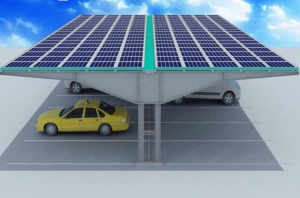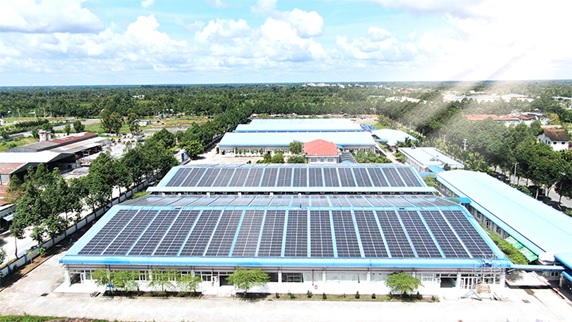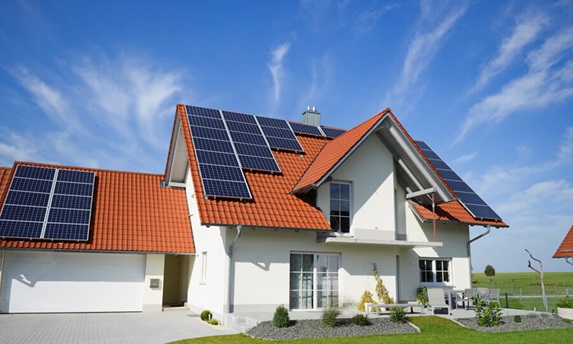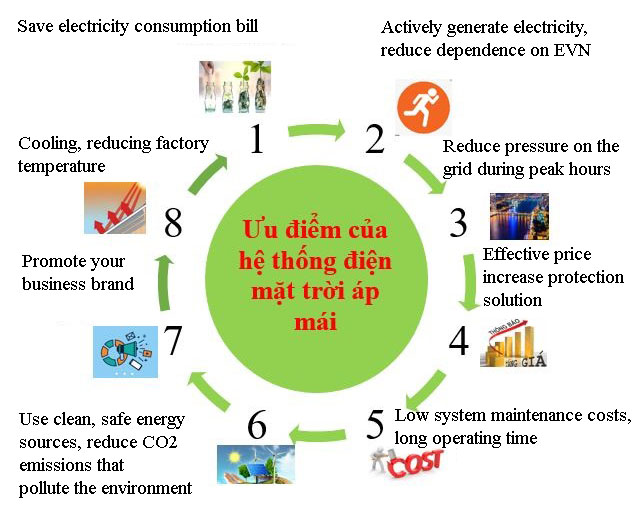Install rooftop solar power
How is rooftop solar power understood?
According to Circular No. 18/2020/TT-BCT, rooftop solar power system (DMTAM) is a solar power system with photovoltaic panels installed on the roof of a building and with a capacity not exceeding 01 MW, directly or indirectly connected to the electricity grid with voltage level of 35 kV or less of the Buyer.
Solar power systems must be installed on construction works with independent functions and must meet the following requirements:
- Construction works are specified in Clause 10, Article 3 of the Law on Construction 2014. Construction works (including new construction, renovation and repair) are invested and constructed in accordance with current regulations on investment. , construction, environment, fire prevention, land,...
- The roof of a construction work is the roof of a house, the roof of a house-shaped structure as prescribed in Appendix 2 of Circular No. 03/2016/TT-BXD dated March 10, 2016 of the Ministry of Construction. The roof of a construction work needs to be suitable for the function and use purpose of the construction work.
-

Điện mặt trời áp mái nhà xe
Giải pháp điện mặt trời áp mái nhà xe
Read more
The Circular provides guidance in some specific cases as follows:
One is: Solar power system on the roof of livestock, farming, forestry, salt production, fisheries and other agricultural and rural development projects: Based on the provisions of Circular No. 02/ 2020/TT-BNNPTNT dated February 28, 2020 of the Ministry of Agriculture and Rural Development (Circular No. 02), livestock and farming farm owners... are responsible for appropriate production and business organization with the planning, land use plan in the area. The assurance that the farm conforms to the master plan and land use plan is within the competence of the locality.
To comply with the provisions of Decision 13, the farm construction must have a roof. The roof of livestock and farming farms, etc. needs to be suitable for the function and type of the farm.

Second: In the case of many solar PV systems with a total capacity of more than 1 MW (each system has a capacity of no more than 1 MW) on one site (on the same piece of land or roof of an industrial park) connected directly. directly or indirectly, by one or more investors; In case an investor acquires many solar PV systems located adjacent to each other, with a total capacity of over 1 MW: According to the provisions of Decision 13 and Circular 18, in this case, each solar system is entitled to a contract to purchase. sell electricity separately and are exempt from electricity activity permits. The acquiring organization and individual may inherit the relevant rights and obligations in the Power Purchase Agreement signed by the previous investors, but must carry out the procedures for transferring the contract owner and must not merge the Power Purchase Agreements. selling electricity from the DMTAM system into a contract.

Thirdly: In case the investor takes advantage of the roof of the office for working, operating, kitchen, motel, employee's garage, workshop, warehouse for storing materials, on the premises of the power project. Solar power plants, hydroelectric power plants, thermal power plants to invest in rooftop solar power and request to install separate meters and sign power purchase and sale contracts for the solar PV system: In this case, EVN is allowed to sign a purchase and sale contract. electricity if it is in accordance with the regulations on the solar power system (in Decision 13 and Circular 18).

Fourthly: In case solar power has a capacity of no more than 1 MW and is not installed on the roof of a construction work with independent functions; in the case of solar power systems of livestock and farming farms... with a capacity of over 1 MW or over 1.25 MWp; in case the solar power system is connected to a voltage level of over 35 kV: In these cases, the selling price of electricity for the solar PV system is not applicable according to the provisions of Decision 13.
Fifth: Proposals for incentives for rooftop solar installations with a capacity of more than 1 MW; If there is a need to use photovoltaic panels for roofs, the Ministry of Industry and Trade will study, propose and report to the Prime Minister for consideration and approval. mechanism suitable to the actual situation, applied after 2020.
Benefits of rooftop solar power

Who should install rooftop solar power system?
Rooftop solar power system is very suitable for business owners, companies and enterprises with large factory area, most of the roof area of these works has no economic exploitation value. . Therefore, the solution of installing solar power on the roof is an extremely effective and beneficial solution.
Households, offices, agencies, schools, etc. can install a solar power system on the roof, as long as there is a demand for electricity and the building structure is qualified to meet the requirements of the job. that installation.
What types of rooftop solar power are there?
.jpg)
- Solar power directly connected to the grid (Grid connection without storage): The system uses a solar battery to absorb sunlight and convert it to DC current. The inverter will then convert that DC (direction) current into AC (alternating) current of the same phase, frequency and voltage to feed into the grid to supply users. At some point, when the electricity output from the solar system generates more than the load demand, it will be sent to the grid, and this excess output will be sold to EVN; On the contrary, there will be a time when the electricity output from the solar system is not enough to meet the load, the grid will make up for that missing electrical energy.
- Independent solar power (Storage): The electricity generated from the solar PV system will be through the charging device to be charged to the storage battery system, then the DC power from the battery will pass through the DC/AC converter ( inverter/exciter) converts into AC power to supply equipment.
- Solar power combined with hybrid (Grid-connected with storage): A hybrid solar PV system is a combination of grid-tied and independent solar PV systems. When the solar system produces more capacity than the load needs, it will be loaded into the storage units to backup in case of power failure or bad weather. In some cases where the load demand is too high, the solar system and storage is not enough, the power grid will be the solution to compensate for that missing energy.
Rooftop solar system components and specifications:
- PV solar panels: convert light energy into DC electricity.
- Solar DC/AC converter (inverter): Converts DC energy generated from PV panels into 1-phase or 3-phase AC power.
- Panel bracket system: keep the PV panels fixed on the roof, and create the appropriate tilt angle for the panels to achieve the highest power generation efficiency.
- DC/AC electrical cabinets: switch, protect the solar power system and the AC part.
- In addition, other materials and equipment such as: DC cable, AC cable, MC4 jack, cos head, .. also contribute to the connection between DC and AC systems to form a complete system.
- Measuring devices (meters), remote monitoring systems help users monitor and monitor the electricity output from the solar system.
The process of installing rooftop solar power system
With many years of experience in the field of supplying and installing equipment for solar projects, Intech Energy has built a real process of installing a standard rooftop solar power system including 8 steps as follows:

Specifications of rooftop solar power system
- Total capacity of rooftop solar power system.
- Types and specifications of energy panels used by the system.
- Number of solar panels in the system.
- Types and specifications of inverters in the system.
- Number of inverters in the system.
- Estimated generation capacity of the system in 1 year.
Points to pay attention to when installing rooftop solar power
- Calculating the balance of the percentage of solar power use and the excess output sold to EVN, from which we will predict the expected installed capacity that best suits the usage needs.
- Thoroughly survey the site, roof structure and installation structure because the structure must ensure load-bearing and safe operation for at least 20 years.
- Select the type of panel that matches the existing roof structure, paying attention to size, weight and capacity.
- Choose the right inverter in terms of type, capacity, quantity, ..
- Calculation and design of the rack frame system ensures the following requirements: Resistance to wind, storm, suitable inclination, minimizing the influence of the shading of the panels, ..
- Select installation accessories suitable for each type of roof structure: corrugated iron roof, concrete roof, tile roof, ..
- Select the plan of arrangement of panels and wiring suitable for the operation and cleaning of the system.
- Selecting a qualified and professional contractor to ensure stable operation of the system, without affecting the existing structure..
- Maintain, maintain and clean the panels for the safest and most efficient system operation


